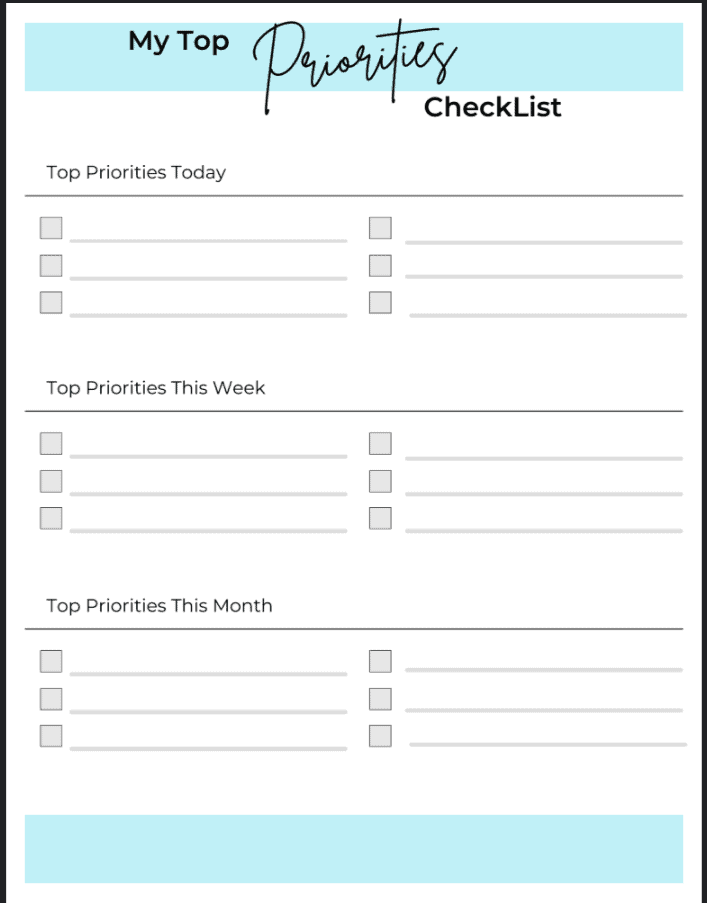Priorities can serve a significant purpose in our lives. Prioritizing helps keep things organized and gives our everyday routines a bit more flow to them.
This is especially true for society today. Losing sight of our priorities is easy to do when there is uncertainty knocking around every corner. The uncertainty can lead to depression and anxiety.
However, there is hope behind it all. Sticking to regular routines and gathering up our priorities will not only help curve any negative feelings but also give us a sense of accomplishment throughout hard times.
We can improve by knowing our priorities and what matters most in life. As well as setting good priorities to help guide us along the way.
Moreover, the prioritizing skills we have gained will be useful tools to continue using in the future. But how exactly does one prioritize?
How to Prioritize
Priorities, by textbook definition, imply what is the primary or first concern of ours.
There really is not a simpler way to put it other than what are the most important things to us and enriches our lives?
Moreover, how do the things we consider priorities benefiting us?
This thought process can be lumped together with things like paying bills, etc. If we don’t pay bills we lose our resources like electricity or water. But priorities go much further than just adult responsibilities.
We tend to prioritize things we hold dear to our hearts that move us emotionally, such as family, values, etc. The key to sorting out our priorities is figuring how to prioritize in the first place. And knowing our emotional and core priorities is key.
If you need extra support and tools from a licensed therapist, I recommend MMS's sponsor, BetterHelp, an online therapy platform that is both flexible and affordable. Get started today and take 10% off of your first month of therapy.
How Do You Set Your Priorities?
The first step to sorting out our priorities is, to be honest with ourselves.
Setting unrealistic goals for ourselves is counterproductive. This is not only true during regular circumstances but also during these circumstances as well.
Having priorities that we are more likely to accomplish and stick to will lead to more success overall.
What are those things that need to be done?
What is most important to you?
This is where the desire for wanting something and the actual need for something should be considered.
Ensuring that debts and bills are paid is a great example of things that need to be done. Protecting our families and loved ones is another example of things that could be considered a need, rather than a want.
These things that are considered a need are classified as priorities.
While you are ultimately deciding what the priorities are in your life, it is important to keep in mind that they should strictly be categorized as needs within your life.
Once the needs have been met, the desirable wants in your life can be approached and obtained.
Not only does this help us feel more accomplished but when we get to access our wants after taking care of the needs and higher priorities, it also gives a sense of completion and relief knowing that we’ve secured them. This gives more purpose to those things we want. That’s why it’s SO important to know your priorities.
After being honest about what our priorities are in life, a list should be made. This may seem tedious, however, lists really put things into perspective. They open up opportunities for us to be even more honest about our goals or priorities. And it gives us a better chance at identifying and knowing which priorities are right.
The list serves as a foundation for us to grow upon and also as a physical thing for us to dedicate commitment to. It also helps us to identify our personal priorities in life. The most important thing is to stay realistic when it comes to prioritizing.
10 Ways to Set Priorities In Life
1. Create your list
As mentioned before; composing a list of priorities helps to keep things in perspective.
It is best if it is a physical list on pen and paper but digital versions can be used as well. Either way, having a list to look at is extremely helpful.
Moreover, this list should stay pretty consistent. Of course, our priorities can change over time, however, some priorities will remain the same such as bills. When our external environments change, our priorities may change as well.
This is where determining what is truly important to you comes into play so the list can be adjusted as needed.
2. Determine necessary over non-necessary tasks
Determining necessary over non-necessary tasks may seem difficult, but it really isn’t. Going back to how to prioritize, consider and weigh all the options of the tasks at hand.
All the ways to set priorities will basically revolve around the list you’ve composed.
The most urgent and important tasks should be at the top of that list. These are the tasks or things you want to achieve first and/or every single day.
If there is still a task you want to complete and consider a personal priority yet it is not that urgent, it may be lower on the list.
3. Don’t overwhelm yourself
It is easy to get overwhelmed. Taking deep breaths and referring to the list will always help.
In fact, the list should serve as a tool to help you see the outlined priorities and work towards tackling them. The key to keeping this list manageable is, of course, being realistic and honest about the list, but also keeping it simple.
The list shouldn’t be overly long. A longer list may imply that you are trying to prioritize too much.
Part of being honest about this list is to consider tasks you know you can complete and you know you are willing to complete. This helps to reduce any chances of being overwhelmed.

4. Be willing to compromise
Compromise doesn’t come easy. This is particularly true for priorities we hold dear to ourselves and our lives. And remember to be open to the fact that our priorities can change over time.
However, compromise is absolutely necessary when it comes to priorities. While we are setting our priorities to get tasks done, there may be roadblocks that set us back a little. This shouldn’t be a discouraging factor rather an opportunity to compromise.
An example of this may transpire in the form of a bill we are trying to prioritize. There may be a moment where an unexpected bill comes up or the need to pay a little more arises.
While this is obviously not ideal, a compromise may need to be agreed upon to ensure that we stay on track with our lists.
Moreover, if the extra bill or unexpected bill arises and it is possible to pay and it will benefit us in the long term, it is best to compromise.
An attempt to meet these new demands will be a compromise we are making to stay aligned with our overall priority list.
5. Assess your most productive days of the week
Every day of the week serves a purpose to us. All of our schedules are different, so each day means something a little different to everyone.
With that said, a great way to set priorities is to utilize the days of the week where we know we’ll have the most energy. Days off from work are often the go-to days for most people.
While this is not a bad idea, it can be harmful too. Spending all of our days off doing our priorities can be overwhelming.
Finding a day that works best for us to try and tackle as much of our list as possible is the best approach.
GRAB MY FREE PRIORITIES CHECKLIST!
Click Here to Download

6. Tackle the hardest task first
When deciding how to make the list or figure out where to start on priorities, tackling the hardest task first is always best. Usually, this task will be something that takes an extended period of time to complete.
Getting a start on this task first will not only be a relief but help in addressing the rest of the tasks at hand. All of the easier tasks will be short-lived and get completed without much thought behind them. This is because these priorities are ones we know can go without fault.
Think of things like laundry for example, or even other household chores. These may be priorities for us and they aren’t as complicated as some of the other things that may arise on the list.
7. Plan ahead
When starting to plan ahead, this doesn’t have to be an extremely early list. In fact, the best way to approach this tip is to end each day by focusing on what may be on the next day’s list.
You’ve just completed your goals for that day and that is such a relief.
Setting up a list for the following day will provide a sense of getting ahead in life. This is because technically you are! You will be able to wake up the next day with some of your priorities already mapped out.
8. Recognize prioritizing will become a skillset
Prioritizing is not something that everyone is born with. In fact, it takes anyone some time to perfect the ability to keep priorities aligned. This ability eventually becomes a skill set.
Having the skill set will bring future success in your overall happiness and preparedness for yourself and your family.
Being able to recognize the value of this skill set will not only motivate you to keep tackling your list every day but also recognize your potential for the future.
9. Create a timeline
Priorities require a timeline. Referring back to the ways to prioritize, this includes being realistic.
Setting too many priorities at once that may overlap is unrealistic.
It is important to build a timeline for certain priorities, especially long term ones like payments or bills. Building a timeline or structuring these priorities helps to relieve the stress of feeling pressured to get them completed.
In uncertain times or any time at all, feeling rushed amplifies the priority list for us. Some people can work under pressure but most of us cannot. Knowing a mapped out timeline of how to approach certain priorities will give light on those rushed feelings.
10 Limit any distractions
Distractions are just that; distractions. When we have our eyes set on priorities we need to accomplish sometimes distractions can stand in the way.
Limiting the distractions we have will help us tackle any priorities we have set for ourselves. Focus is critical in reaching our priority goals.
Priorities List: What are Examples of Priorities?
Once again, everyone’s priorities are going to be different. However, there are some commonplace ones that exist, especially in today’s society, that can apply to just about everyone. Below are some examples of common priorities.
-
Pay household utility bills.
-
Pay off loans.
-
Pay off credit debt.
-
Get a house loan.
-
Become more self-sufficient.
-
Learn a new skill.
-
Complete household projects.
-
Do household chores.
-
Open a savings account.
-
Learn to manage money better.
-
Learn how to save money.
These are just some examples but there are many more that can exist to each personal preference for a priority.
Final Thoughts
Priorities are something we all have and want to tackle. With the strains of life and work sometimes getting those in order can be stressful.
However, it does not have to be that way! It is possible to learn to prioritize and learn to optimize our personal priority lists! How will you determine your top priorities in life? How will you identify your personal priorities? Make that list and get started!


